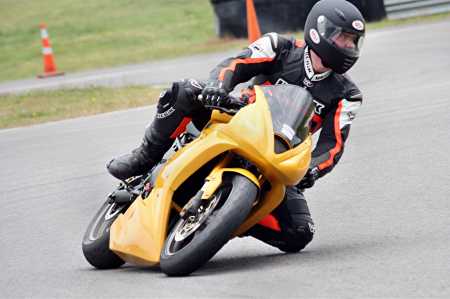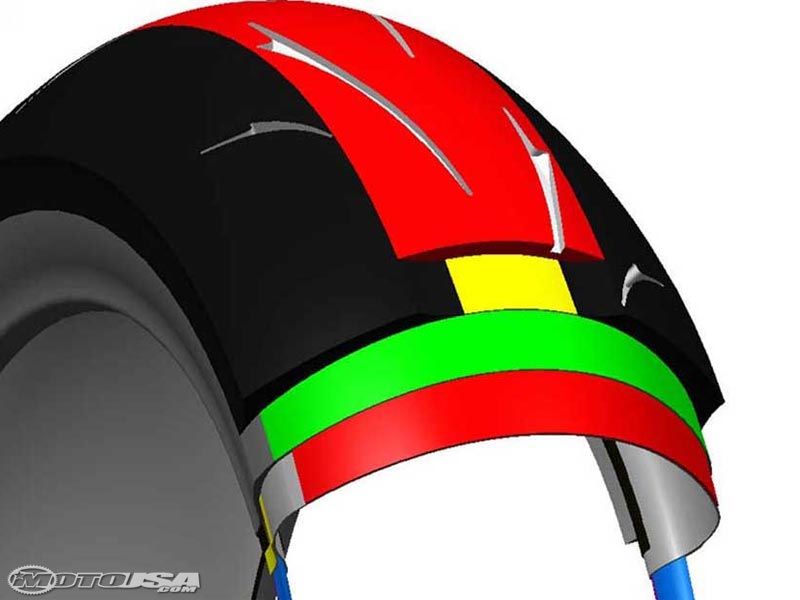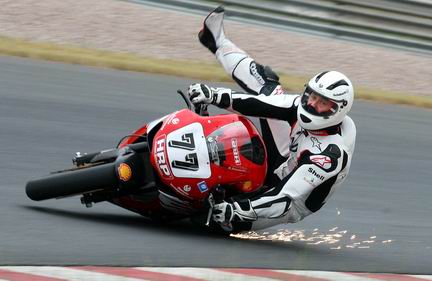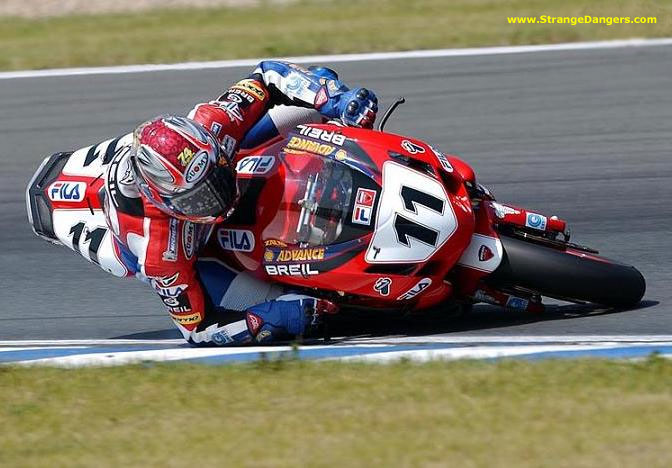Ok, there are so many things said about motorcycle tyres that are just not correct and may lead you into trouble, if not, at least into wasting money.
Some of the biggies are:
- you need the sportiest tyres you can get, the softer the better for maximum traction.
- a tyre is good until the tread is worn out
- bigger tyres give you more grip
- all tyres are the same
- you can use sandpaper to “scrub” in a tyre, or gravel or … pick another abrasive.
Grip is about tread
On a road bike at least, grip is NOT about tread. Tread is actually bad for ultimate grip, grip comes from CoF (Coefficient of Friction) and tread just introduces heat that can help but also more often hinder.
Take a look at Finding traction if you want to really understand where traction comes from (on a road bike).
There is a reason that race bikes, on a dry track, use slicks, i.e. no tread. It makes for a grippier tyre and also more heat stable, which is much better for a lot of reasons that will become clear.
Tread is about moving water out of the way of the rubber and stopping aquaplaning on the grip surface. The bits without tread cuts, i.e. the landings.
Tyres are good until the tread is gone
Tyres are road legal until the tread is worn to a certain level, set by law different in each country.
This does not mean they are good. Grip still depends on CoF and that depends on the composition of your tyres that changes as they go through heat cycles; too many heat cycles and they will start to lose grip, even if the tread is still in great condition.
Now a caveat to this is road tyres. Their tread tends to be a harder compound and therefore have a greater heat cycle tolerance, and so the tread usually is worn out before the rubber.
BUT and it’s a big but, if you run very sporting tyres that are very soft or use race like compounds, this might possibly, very possibly, not be true.
The other thing is that once a tyre goes through its first few heat cycles, they become susceptible to oxidation which will form a hard layer on the outside of the tyre. And beware of old tires that have not been used for a long time!!!!
Heat cycles is what its all about
Heat Cycles? What? Let’s explain. When you ride your bike you generate heat in your tyres.
Pretty simple, right? The harder you ride or the hotter the temperatures the more heat is generated. Still makes perfect sense, right?
Tyres are designed to have an optimal working temperature. As they get hotter they get softer until their chemical bonds start to break down and they actually become slippery to ride on. We , as racers, call this having a tyre “go off”.
So each time you ride your bike, your tyres heat up and cool down. These are called heat cycles. The degree to how much your tyres heat up is dialled into the manufactured chemical structure of your tyres.
That is to say, race tires take a lot to get hot because they have to go through torture in a race and not overheat. They are also. designed to work at higher temperatures so you don’t get full grip until they are quite hot. Each time a tyre goes through a heat cycle it changes, slightly, but you feel it, its chemical structure actually changes and its ‘moo,’ – its CoF – gets a little higher until it reaches a peak and then it starts to go the other way.
So it’s all about heat cycles for grip and how good your tyre is.
The above article, What are the Limits, goes into the math pretty hard, but if you can handle a short power read you’ll be a tyre expert at the end.
Age vs heat cycles and oxidation
So the age and number of heat cycles your tyre has been through is way more important to you than how much tread is left on the thing.
Unless it’s only being legal you care about or perhaps you are a gentle rider and don’t need the full traction that the tyre originally offered.
New tyres are slippery, because of release agent
Ok. We know, or at least I hope we know, that new tyres offer very limited grip until they are “scrubbed in”. Every tyre changer will tell you stories of riders crashing just outside because they didn’t understand this.

Now many of us think that this is because new tyres were made using a “release agent” to help get the tyre out of the mould and that needs “scrubbing” off before the tyre is no longer “slippery”.
Sorry, that’s a load of old bollocks I’m afraid. Tyre manufacturers have not used “release agents” for years. But you still crash out of the gate if you give it a handful, right out of the gate.
Why???? Heat cycles my friend – heat cycles.
The tyre is made with a coating to protect it against oxidation, but this is quickly worn off, the main thing that protects it against premature ageing if you like, is the fact that the rubber compound needs to go through a number of heat cycles to chemically change before you get that grip you were promised in the brochure – which also makes it susceptible to oxygen.
Now here is an important point, THERE IS NO SHORT CUT FOR THIS. This is why racers pre-scrub tyres before they use them in a race and why some race tyre warmers are capable of reaching over 100c (212f for the rest of us). You need to get heat into your tyres, let them cool and do it again.
The only way to accelerate it a little is lower tyre pressures, but I would not recommend you do this as you have no real control over the effect you get. Do what the manufacturer recommends and do it gently feeling your way into the grip (and hopefully out of it as the tyre wears out (i.e. runs out of heat cycles).
Sports tyres will scrub in quicker and touring tyres will take longer, BTW, because of their tolerance to heat cycles and hard/soft compounds.
Bigger tyres are better
Bigger tyres are better. Again what a load of rubbish. Smaller tyres will give you much more agility and , if you bothered to read “finding Traction” above you’d know that CoF has no relationship to surface area. Its a common fallacy.
Rather bigger tyres have bigger tensile sheer strength that handles bigger forces better but won’t offer any more grip.
Read the article recommended above, it’ll clear up A LOT of confusion in this area.
Cf Vs Sheer strength
Moo, or Co-efficient of friction does NOT increase as the area increases only as the pressure, or weight pushing two surfaces together increases.
Tensile strength, however does increase by the square of the area so bigger tyres can take more power before getting too hot or simply stripping layers off onto the road.
This is the main reason for…..
Why big bikes have bigger back tyres than front
There are greater forces going through the rear tyre than the front and the greater surface area allows better stability control, heat control and tensile strength to get power down consistently. Big engines produce LOTS of power. The front doesn’t need to deal with this, only with the weight of the bike. Hence a 1000cc front tyre might be the same as a 600cc bike, but the rears will be completely different.
Too big and you gain only weight and lose agility and handling. Imagine if you would the extreme of a 300mm tyre on a 50cc scooter. No more grip, just more weight and unsprung weight than probably the entire scooter and an inability to generate a thing called tread walk, which is needed for handling on a bike (or scooter). In other words a scooter that might have trouble going forward but will definitely have trouble going around corners.
Don’t buy wider, thinking you’ll get more grip. The bike manufacturer choose your tyre balance for just that, balance between tyre walk front and rear. So you don’t get under or oversteer.
I’ll write an article in the coming weeks that goes into more detail on tread walk, but in a nutshell, as a tyre rolls around an arc (a corner) it slides wide somewhat depending on the forces on it. This phenomenon is known as tread walk and you want the amount of tread walk on the front and back of the bike to align to some degree or your bike will have under or oversteer. We talk about how to control it using throttle in….
Sports tyres give you more grip
Yes they do.. BUT.
Soft compound tyres designed for high performance use do offer you more grip, less tread and therefore lower grip in adverse conditions, but also higher tolerance to being ridden very hard and not “going off”, losing their grip.
The problem is because of this, they require to be at a higher temperature to offer that higher grip, they have much lower tolerance to heat cycles and so will have a shorter life where they will offer better grip, they also are slower to warm up and therefore not great for the daily commute.
Good sports tyres will offer you more, but only if you ride them as they were designed to be ridden and change them as they get harder (through more heat cycles) and don’t hang onto them for the tread for wear down.
For most of us, riding to work, or in a city and being in traffic where our tyres are cooling off, high performance tyres will actually, most of the time, offer us much less life, less grip, less feeling and less money. But nothing else.
Softer is better
Even on the race track this is NOT true and on the road this definitely is NOT true.
We have all seen the racer, gamble with a softer compound, gain an early lead and then lose it drastically as his tyres “go off” later in the race. Softer is not always better.
Personally I ride rather hard on the road. I am not known for hanging around and I also ride aggressively. BUT I do not ride sports tyres on the road. Sports touring tyres I find warm up quicker, hold their heat longer and so don’t cool off when I get caught in traffic, last much longer and still, once warm and ready will out lean my rather aggressive V-Twin.
When you buy your tyres, think about how you are going to use them. For instance on my race bike… I use race compound sticky and short lived tyres that spend their entire day on tyre warmers whilst not actually doing their job on the track. But on the road, only a waste, less grip, less safety and they last about 600Miles vs the Sport Touring tyres lasting 10,000Miles, even with me riding :-).
Tyres have a personality
Lastly, tyres do have personalities. They are not all the same. The personality tends to vary from manufacturer to manufacturer, but can also be between different models.
Learn your tyres and what you like from your tyres, learn the brands, which means try them and choose based on the personality you feel comfortable with.
For instance, I LOVE Dunlop tyres and close behind would be Continental. They offer great grip and “feel” but part of my love for them is the way they move about with the bike and power. The way I can generate tread walk and get oversteer on a V-Twin. The way I can “feel” my way into the braking corner with the front squirming away.
I’m less fond of Michelin and Bridgestone because they tend to just not move, to hold on like there is no tomorrow and when you find the limits, they just let go. In Michelin’s case big time and in Bridgestones case, usually a sudden slip, then grip.
Many riders like the confidence that these tyres give them, they are like being on rails until you reach the limits. But I like the feel and progressive “slide” tyre feed back I get from Dunlop and Continental. So it’s personal and personality.
Having said that, the Bridgestone race tyres are far more like Dunlops than their road cousins. So you need to ride them, find what you like and develop a style that fits your preference.






